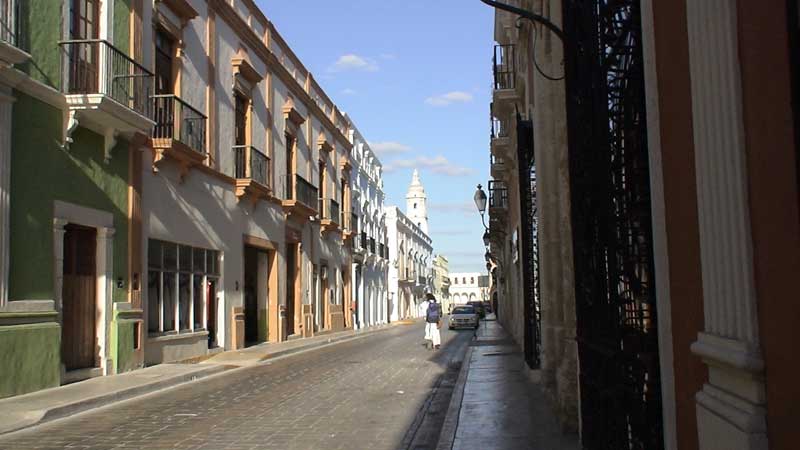
| Previous Page . . . | Next Page . . . |
 |
| The coastal city of Campeche, Mexico. There's my friend Nacho who is walking the streets of downtown looking for the pirates house. Observe the multicolored colonial buildings and the small lanes with the tower from the Zocalo in the background. |
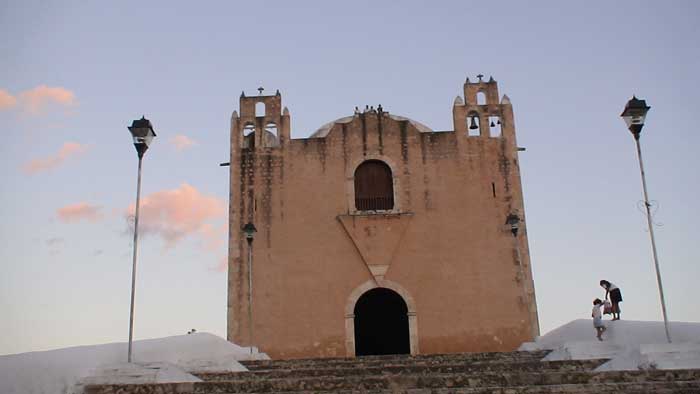 |
| St. Elena was a small town where Nacho, Pato and I stopped on our way to Uxmal. Mexicans in cowboy hats chatted in the Zocalo and school kids played futbol at the field beside the the church. There is also a museum here which contains artifacts and evidence that some Mayans mummified their dead. |
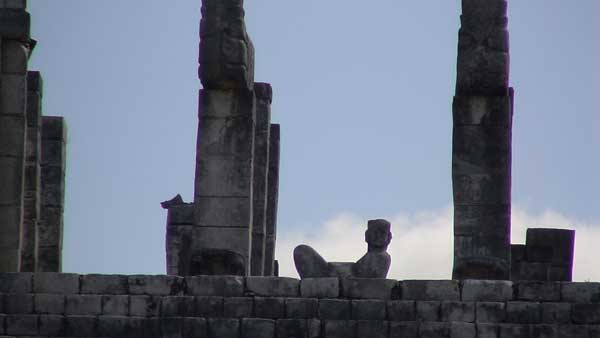 |
| Chichen Itza, Yucatan. Nacho wanted me to take a photograph of this because it appears that the statue is doing a very difficult asana or yogic posture. |
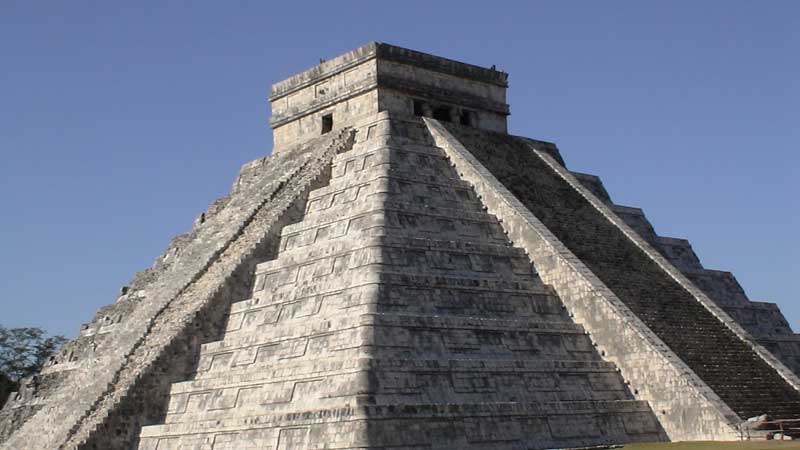 |
| El Castillo, Pyramid of Kukulcan in Chichen Itza. The Mayans had an intricate calendar system and this pyramid is a stone representation of their calendar. "The four stairways have 91 steps each: add the top platform and the total is 365, the number of days in a year. During the spring and autumn equinoxes, light and shadow form a series of triangles on the side of the north staircase that mimic the creep of a serpent." |
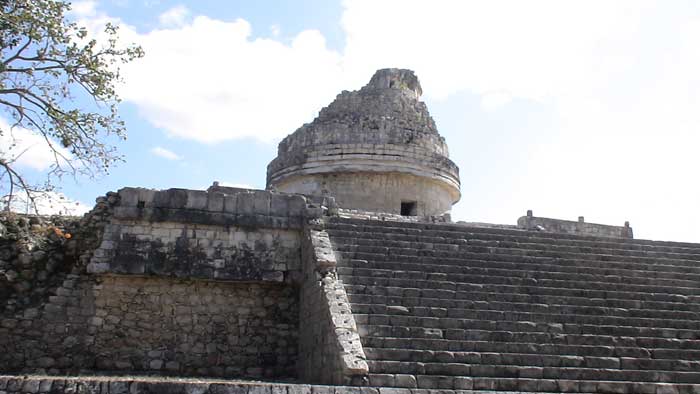 |
| El Caracol, the Observatory in Chichen Itza. "The windows in the observatory's dome are aligned with the appearance of certain stars at specific dates." Nacho said that one night he and his friends had sneaked into Chichen Itza and slept in El Caracol. |
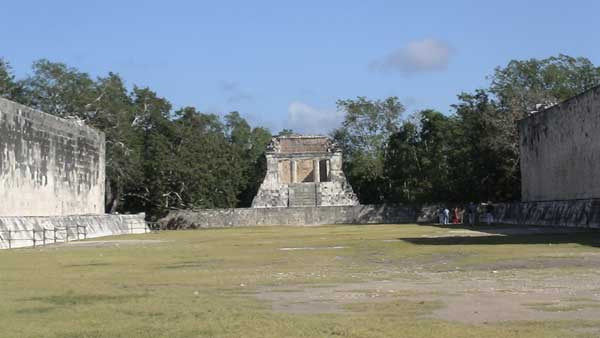 |
| This is a huge ball game field. The ball game was famous in the Mayan world and can be seen at most of the major archeological ruins. |
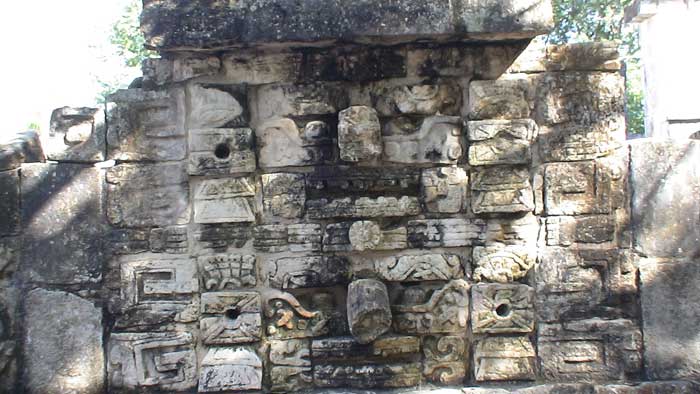 |
| Nacho, Pato and I drove for hours through a circular rode called La Ruta Puuc in the Yucatan. We passed Sayil, Labna, Xlapak, Kabah and finally Uxmal. Dozens of huge Chaak masks for the rain god Chaac, like this one, were carved into the walls at Kabah. |
We caught a bus to the playas, the playas as the name implies are not beaches but seemed to be a central junction for main roads and bus routes. Nacho provided me with breakfast, hard bread and Oaxacan string cheese, carved out of a ball with a knife and chased down with chocolate milk. Then we began the process of hitchhiking. Nacho warned that sometimes it could take several hours to find a ride, but we found a pickup truck in just a few minutes. The driver, wife and child wore their hair in dreadlocks and were heading towards the coast. They reminded me of the family from Mad Max, driving down the barren road. Nacho and I sat in the back of the pickup on top of a sack of clothes. The wind blew hard over our faces. They couldn’t take us all the way to Campeche, so they dropped us off somewhere in between. After unsuccessful attempts to hitchhike again, we boarded a crowded bus and stood for 2 hours in the aisle. We were only in Campeche for an hour or so, but the colonial streets and beautiful people charmed me. We saw the beach through a portico but did not approach it. The city seemed exceptionally clean. We rambled around, had some taquito-like snacks with cheese and salsa, spent some time in the Zocalo and then tried to find the pirates house which was a cheap guest house. Nacho was not satisfied with the accommodations, so we decided to take a bus to Merida the same day. Nacho’s hometown. When we arrived, he immediately started off in his whirlwind fashion, briskly prowling the streets and we ran into a handful of his friends. Posters everywhere informed people that the Zapatistas would be arriving in Merida the following week. We sat in a café and had coffee with a painter named Pancho, who had painted a wonderful picture that Nacho was trying to sell. I had an iced frappuccino with lots of whipped cream that probably pushed my digestive system over the limit. Later that night we arrived at the house of Nacho’s parents and I greeted his mother who was caring for a litter of puppies. She was a dog breeder. Nacho’s room was filled with books, trinkets, paintings, two computers, a hammock, a chest of drawers and a large bed. He had collected some indigenous clothing and gave me a pair of hand spun pants. It was an incomparable feeling to sleep in real room after sleeping in dorms, guest houses and buses. I had a hot shower, scrubbed myself from head to toe, gave my clothes for laundry and then retired to Nacho’s room to sample his books and music. We finally settled on the music of Bhagavan Das. Nacho lent me a dhoti, which he taught me to tie in the Hare Krishna style, and a kurta. The next morning I was having a fever and stomach indigestion, so his mother gave me 2 aspirins and some medicine for my stomach. I felt fine by the end of the day. We had to stop in Nacho’s University before we left for Mani. Mani was the town where Nacho lived and conducted his archeological studies. We decided to take Pancho’s painting to sell at the University. He left me sitting on a bench in the front of campus, and walked inside to complete his work. So there I was dressed in a dhoti kurta with black sneakers and sitting with Pancho’s painting. It was the beginning of the semester and students and teachers streamed into the University. Nacho gave me one of his books on Mayan archeology and I started reading the first chapter. A student sat down next to me. It turned out that she was from UC San Diego, where I had gone to school, and was studying civil engineering in Merida. One of her friends joined us. Nacho returned and we held an enjoyable conversation. Unfortunately we had to leave, but we stopped for a meal of fresh juice and soy burgers at Lakshmi, a natural food store. Thus satiated, we drove to Mayapan which was about halfway to Mani. We had the ruins mostly to ourselves, so we leisurely scaled the pyramid and studied the carvings near the observatory. Mayapan is a walled city that served as the capital for the Mayas before the Spanish arrived. There are some interesting painted murals and Chaac masks. It was great to have Nacho there as a guide. Nacho said that he admired three cultures in the world, the Japanese, the Maya and the Hindu. We arrived in Mani that afternoon and visited Nacho’s landlady and a friend named Pato. Pato was extremely hospitable and invited us inside, offering us Mayan delicacies to eat. One of the foods seemed like sweet potatoes while the other was some sort of cake. This was all washed down with fresh papaya juice. Pato lived in a one room Mayan hut with a thatched roof and wooden walls. In the backyard chickens and turkeys roamed about. Nacho invited Pato to accompany us to Uxmal in the evening. I should say that riding in Nacho’s small station wagon was an exhilarating experience, finally the freedom to stop wherever we pleased. Nacho flew down the roads at twice the speed limit passing cars and trucks as they appeared. “I’m very familiar with this road,” Nacho explained. I didn’t see any police around and wondered if traffic tickets were give as frequently as they were in LA. La Ruta Puuc is an outstanding road with trees and jungle on both sides. The road curves continually and you will see signs for various archeological sites in the area. Some of the ruins are Labna, Sayil, Xlapak, Kabah and the Grutas de Loltun. The latter is a labyrinth of caves with artifacts and murals inside. We stopped at Kabah to see numerous Chaac masks carved into the wall. Nacho meditated and did head stands while I walked the ruins. The setting sun proved a powerful backdrop to the hallowed buildings. Night fell and we broke our journey at St. Elena. You can see the remains of small children mummified and other embalming objects in the “mummy” museum. We had some refreshments and an oily meal of French fries and spicy potato chips in the Zocalo. The sound and light show in Uxmal was in Spanish, so Nacho graciously translated for me. It seemed to be about the rain god Chaac and a palace intrigue regarding a wedding that was foiled due to a love triangle. The life of the Mayas diminished after they fled Uxmal and moved to Mani. In fact there are two histories of the Mayas, one before Mani and one after Mani. So we drove back to “Mani” and spent the night in Nacho’s Mayan hut. He had a large backyard and another hut for a kitchen. The bathroom was outdoors free style. Nacho had not been in the hut for a while, so I did my best to clean off the cushions and laid blankets over them. Nacho showed me pictures of his friends and told me stories of Lalo, Philippe and Corrine. I slept peacefully by the light of a candle. Pato arrived in the morning with fresh milk and then we were off to Chichen Itza. We stopped in Valladolid for a meal of gorditas filled with nopales (cactus), beans and cheese. I admired Nacho for walking barefoot everywhere in his white dhoti. The drive was fresh and pleasant. At one point Nacho wanted to roll a joint, so we pulled off the road and I took over the wheel. Driving the narrow road with blooming trees on either side was a thrill. We sang mantras and bhajans in the car and drank horchata (rice drink) or whatever fresh juice we could find. Om Jaya Shankara Bum Bum Hare Hare For a few dollars we could sleep in an outdoor “palapa” in the Piramide Inn near Chichen Itza. Nacho brought a sleeping bag and blankets in the car, luxurious I could not carry in my small backpack. Chichen Itza is perhaps the most famous and accessible of the Mayan ruins. Busloads of tourist groups arrive from Cancun. However, the site is fairly large with plenty to see and many paths to explore. The Pyramid of Kukulcan is the most imposing structure, a highly mathematical design that symbolizes the Mayan’s understanding of time and seasons. You can walk through the “group of a thousand columns,” which is a forest of pillars strung through several temples, or behold the wall of skulls thought to be the heads of sacrificed warriors. We sat for a long time in front of El Caracol, the observatory, and Nacho spoke about his previous visits to Chichen Itza. The priests in Chichen Itza used the observatory to predict the time for rituals, harvests and celebrations. |
Movie Clip
Please press play
Travels with Nacho in the Yucatan. Campeche, Mayapan and Kabah |
| Next page . . . |